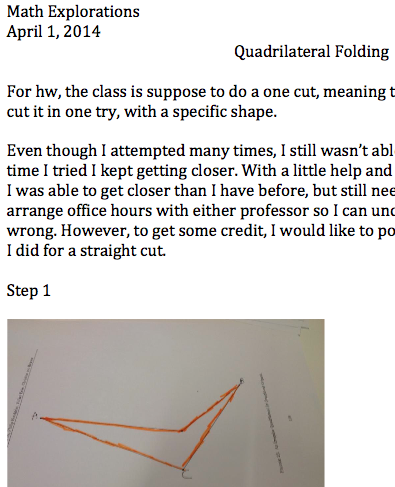Homework Stories: Observing Student Thinking.
Written by: Dr. Christine von Renesse.
Assignments
Students need to practice their reasoning skills and learn how to present an argument in writing. Once a week my students write up in detail the solution to one of the problems we have been working on during the week. I like to pick a question that reveals the main mathematical idea or a problem that connects several ideas with each other. This assignment also gives the students a chance to reflect about their strategies and find holes in their arguments.
I want my students to learn how to write about their thinking. Often mathematics homework is just a collection of numbers and variables with little to no explanation. The reader then has to guess what the student might have thought and feedback and grading is arbitrary at best.
Since I don't want that, my assignments have to be written in full sentences, explain every computational step in detail and convey the mathematical concepts and ideas at hand. They can also contain the story of how the student discovered the solution, including all struggles and mistakes. (You can find my grading rubric below.)
Student Work Example:
The first example is from our Origami chapter in the Art and Sculpture book. The students have to cut out a polygonal shape with one straight cut. The challenge is to fold the paper so that this is possible.
![]() Student work: Straight Cut Origami, You can find a second example (from Calculus) at the end of the blog.
Student work: Straight Cut Origami, You can find a second example (from Calculus) at the end of the blog.
Reflections
This last semester I found myself enjoying grading the weekly homework, even late at night when I was tired. What had changed? I used to get bored by grading and used to call it the “worst part of my job”!
I had managed to convince my students to really share their thinking with me – including what did not work and what still didn’t make sense. I was reading the story of their homework, not just the result. And I learned so much about their thinking that it captivated me.
My ![]() Writing Rubric has included details about write-ups for many years. But recently I have started to ask my students to tell me a story, to consider me as their captive audience (that has to read 30 of these assignments). I used something like the following speech: “I would like you to write like this: first I tried… but that didn’t work so I got frustrated and got a coffee and tried again and here is what happened….”. They laughed and remembered that I really care about their thinking much more than after reading my rubric (if they ever did read it). Most students’ writing became more relaxed and personal and much more fun to read.
Writing Rubric has included details about write-ups for many years. But recently I have started to ask my students to tell me a story, to consider me as their captive audience (that has to read 30 of these assignments). I used something like the following speech: “I would like you to write like this: first I tried… but that didn’t work so I got frustrated and got a coffee and tried again and here is what happened….”. They laughed and remembered that I really care about their thinking much more than after reading my rubric (if they ever did read it). Most students’ writing became more relaxed and personal and much more fun to read.
But maybe the change was not only in what I expected of my students but also in my own disposition. What am I curious about? What do I want to know?
I collaborated this semester with some wonderful K-12 educators who know a lot about how to look at students’ work and analyze their thinking. See also http://www.lasw.org. Their lens of analyzing work is very objective and removed from evaluating or finding a grade. It is all about the student’s thinking:
- The student knows… here is the evidence.
- The student doesn’t know… here is the evidence.
- What is the student ready to learn next?
- What could I do to make that happen? What are questions I could ask?
I have always enjoyed sitting with a student and watching him or her think. Now when I grade I am doing just that: I watch the student work and write questions when I don’t understand something. My goal is to further the student’s thinking in the moment the homework is returned and read. The correct answer is not that important, how to get there is the interesting part.
My goal has changed. Before I wanted to primarily put a grade to the work and be done. Now I want to know about the particular student’s thinking and use this information to plan my next interaction with the student (and the next class). That this happens to create a grade that I can use for a total homework grade is convenient but is not my priority anymore.
Second Student Work Example:
The second example is from my calculus 2 class. Student work: Calculus 2 The assignment was to answer the second page of
![]() cai.6_distinguishing_series_and_definite_integrals.pdf and the first 3 explorations of
cai.6_distinguishing_series_and_definite_integrals.pdf and the first 3 explorations of
![]() cai.7_velocity_and_distance_travelled.pdf. These investigations are from www.iblcalculus.com, a wonderful resource for an IBL calculus class developed at Rockhurst University.
cai.7_velocity_and_distance_travelled.pdf. These investigations are from www.iblcalculus.com, a wonderful resource for an IBL calculus class developed at Rockhurst University.


